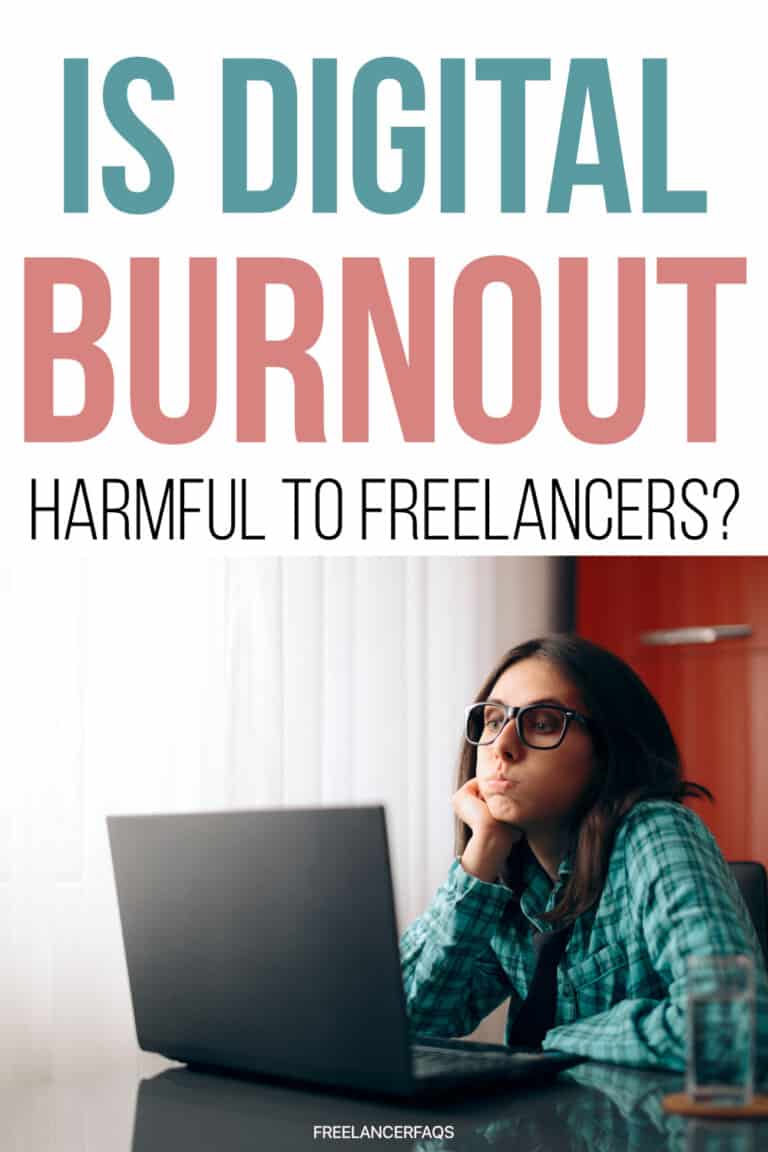In our modern, fast-paced world, we absolutely love the freedom and flexibility that comes with working remotely as a freelancer.
But let’s face it: being constantly connected and dealing with the never-ending demands of the digital realm can really drain our energy and impact our overall well-being.

As a full-time freelancer myself, I understand firsthand the challenges of managing digital burnout.
And if you’re been curious about the potential harm of digital burnout, you’re in the right place!
Let’s take a look at what digital burnout is, what the signs are, and how you can deal with it whether you work from home or on the go.
What is Digital Burnout?
Digital burnout is a pervasive issue that arises from the constant connectivity and high demands of the digital age.
It encompasses a state of exhaustion, both physically and mentally, experienced by individuals who are consistently plugged into their work through digital devices.
Freelancers, in particular, face unique challenges that make them particularly susceptible to digital burnout.
Balancing multiple projects, clients, and deadlines while working independently can quickly lead to feelings of overwhelm and stress.
Freelancers often find themselves immersed in a perpetual cycle of responding to emails, attending virtual meetings, and delivering work on tight schedules.
The absence of traditional workplace boundaries, coupled with the pressure to constantly stay connected and available, can significantly impact their well-being.
As a result, it is crucial for freelancers to be aware of the signs of digital burnout and take proactive steps to mitigate its effects.
The Signs of Digital Burnout
By being aware of the signs of digital burnout, freelancers can take proactive steps to protect their well-being and maintain a healthy work-life balance.
Let’s take a look at those signs:
1. Persistent Exhaustion
Persistent exhaustion refers to feeling consistently tired, both physically and mentally, despite getting an adequate amount of sleep.
Freelancers experiencing digital burnout may wake up each day feeling drained and lacking the motivation to start their workday.
The fatigue they experience goes beyond normal tiredness and can hinder their ability to perform tasks efficiently and with enthusiasm.
2. Decreased Productivity
Digital burnout can have a significant impact on a freelancer’s productivity.
They may struggle to concentrate and find it challenging to stay focused on their work.
As a result, their ability to meet deadlines and deliver high-quality work may suffer.
Simple tasks that were once manageable may now feel overwhelming and daunting.
The decline in productivity can further exacerbate feelings of stress and frustration, creating a cycle of burnout.
3. Increased Irritability and Negative Outlook
Burnout can take a toll on a freelancer’s emotional well-being, leading to increased irritability and a negative outlook.
They may find themselves becoming easily frustrated, agitated, or even angry over minor setbacks or challenges.
The constant stress and pressure of their workload can lead to a shift in their overall perspective, causing them to develop a negative attitude towards their work, clients, or projects that they used to find fulfilling or enjoyable.
4. Lack of Satisfaction and Engagement
One of the hallmark signs of digital burnout is a diminished sense of satisfaction and engagement in work.
Tasks that once brought joy or a sense of fulfillment may now feel monotonous, repetitive, or burdensome.
Freelancers may struggle to find intrinsic motivation and may question the purpose or value of their work.
This lack of satisfaction and engagement can further contribute to a cycle of burnout and decreased productivity.
5. Physical Symptoms
Digital burnout can also manifest in physical symptoms that can impact a freelancer’s overall well-being.
Headaches, muscle tension, digestive issues, and a weakened immune system are common physical symptoms associated with burnout.
Frequent illnesses or a general decline in health can be indicative of the toll that constant stress and exhaustion are taking on the body.
Recognizing and addressing these physical symptoms is crucial to preventing further deterioration of one’s well-being.
6. Difficulty Disconnecting
The digital nature of freelance work can make it challenging to disconnect and establish boundaries between work and personal life.
Freelancers experiencing burnout may find it difficult to switch off from work, constantly checking emails, responding to work-related messages, or thinking about their to-do list even during their supposed downtime.
This difficulty disconnecting can lead to a lack of work-life balance, further perpetuating the cycle of burnout and preventing proper relaxation and rejuvenation.
7. Social Withdrawal
Burnout can cause freelancers to withdraw from social interactions and isolate themselves.
They may feel emotionally and mentally drained, making it challenging to engage with others or participate in social events.
The desire to disconnect and escape from work-related stress can result in a sense of disconnection from friends, family, and the wider social circle.
Recognizing this withdrawal and seeking support is crucial for mitigating the effects of burnout.
8. Loss of Motivation and Passion
Digital burnout can cause freelancers to experience a loss of motivation and passion for their work.
The activities they once enjoyed and felt passionate about may now feel like mere obligations.
A sense of apathy or indifference can pervade their work, making it difficult to muster the energy and enthusiasm needed to perform at their best.
Restoring motivation and reigniting passion are vital to prevent burnout from becoming a long-term issue.
How to Deal with Digital Burnout as a Freelancer
 Now that you know how to recognize digital burnout, let’s take a look at some practical strategies and tips to help freelancers effectively deal with digital burnout and regain a healthy work-life balance.
Now that you know how to recognize digital burnout, let’s take a look at some practical strategies and tips to help freelancers effectively deal with digital burnout and regain a healthy work-life balance.
By implementing these techniques, you can protect your well-being and continue to thrive in your freelance career.
1. Practice Effective Time Management
Digital burnout often stems from feeling overwhelmed and constantly racing against deadlines.
Implement effective time management techniques, such as creating schedules, prioritizing tasks, and breaking larger projects into smaller, manageable steps.
Utilize productivity tools and apps that can help you stay organized and focused.
2. Embrace the Power of Disconnecting
Freelancers often find it challenging to disconnect from work, as the digital world is always accessible.
However, it’s crucial to set aside time for complete disconnection.
Establish regular digital detox periods where you disconnect from work-related notifications and immerse yourself in activities that bring you joy and relaxation.
3. Regularly Assess and Reassess Your Work-Life Balance
Periodically evaluate your work-life balance to ensure it aligns with your priorities and well-being.
Assess the amount of time and energy you dedicate to work, personal life, and self-care.
When you need to, make adjustments to maintain a healthy balance that supports your overall happiness and fulfillment.
4. Embrace Flexibility
One of the significant advantages of freelancing is the flexibility it offers.
Leverage this flexibility to integrate your work and personal life more seamlessly.
Identify opportunities where you can blend work tasks with personal activities.
For instance, you can work from a coffee shop or a park, allowing you to enjoy your surroundings while staying productive.
Digital Nomad Burnout – How Much Travel Is Too Much?
The allure of the digital nomad lifestyle lies in its promise of adventure, freedom, and being able to work from anywhere you want in the world.
However, constant travel can bring its own set of challenges and contribute to burnout.
But the question of how much travel is too much for digital nomads is subjective and depends on many things.
So while the allure of constant travel may be tempting, it’s essential to strike a balance that promotes well-being and prevents burnout.
Here are some considerations to help determine how much travel is too much:
1. Mental and Emotional Well-Being
Think about the impact of constant travel on your mental and emotional well-being.
Frequent travel and work can be physically and emotionally draining, making it important to prioritize self-care and rest.
If you find yourself feeling overwhelmed, exhausted, or lacking a sense of stability, it may be an indication that you need to reduce your travel frequency.
2. Building Relationships and Community
Building relationships and a sense of community can be important to the digital nomad, and constantly being on the move can make it challenging to form and maintain a support network.
Finding a balance that allows you to establish meaningful connections and engage with local communities can contribute to your overall well-being.
3. Personal Growth and Exploration
While work is a significant aspect of the digital nomad lifestyle, personal growth and exploration are also important.
Take a look at whether your travel frequency allows for sufficient time to immerse yourself in new cultures, explore local attractions, and engage in personal development activities.
Striking a balance between work and exploration is crucial to avoid feeling like you’re constantly on the go without fully experiencing your destinations.
4. Regular Breaks and Rest
Regardless of your travel frequency, prioritizing regular breaks and rest periods is vital for preventing burnout.
Be sure to integrate downtime into your travel schedule to recharge, reflect, and rejuvenate.
This could involve staying in a single location for an extended period or taking intermittent breaks from travel to focus on self-care and relaxation.
Nurturing Well-being: Striking a Balance as a Freelancer
In the dynamic world of freelancing, where digital connectivity is constant, it’s essential for freelancers to prioritize their well-being and guard against digital burnout.
By understanding the signs of burnout and knowing how to deal with it, freelancers can safeguard their overall health while enjoying the flexibility of their profession.
As a freelancer. you need to be proactive in managing their well-being and avoiding digital burnout.
Make sure you are finding ways to strike a harmonious balance that works for you and allows you to thrive in your profession while enjoying the freedom and flexibility it offers.
Remember, taking care of oneself is not a luxury but an investment in long-term success and fulfillment as a freelancer!




Leave a Reply